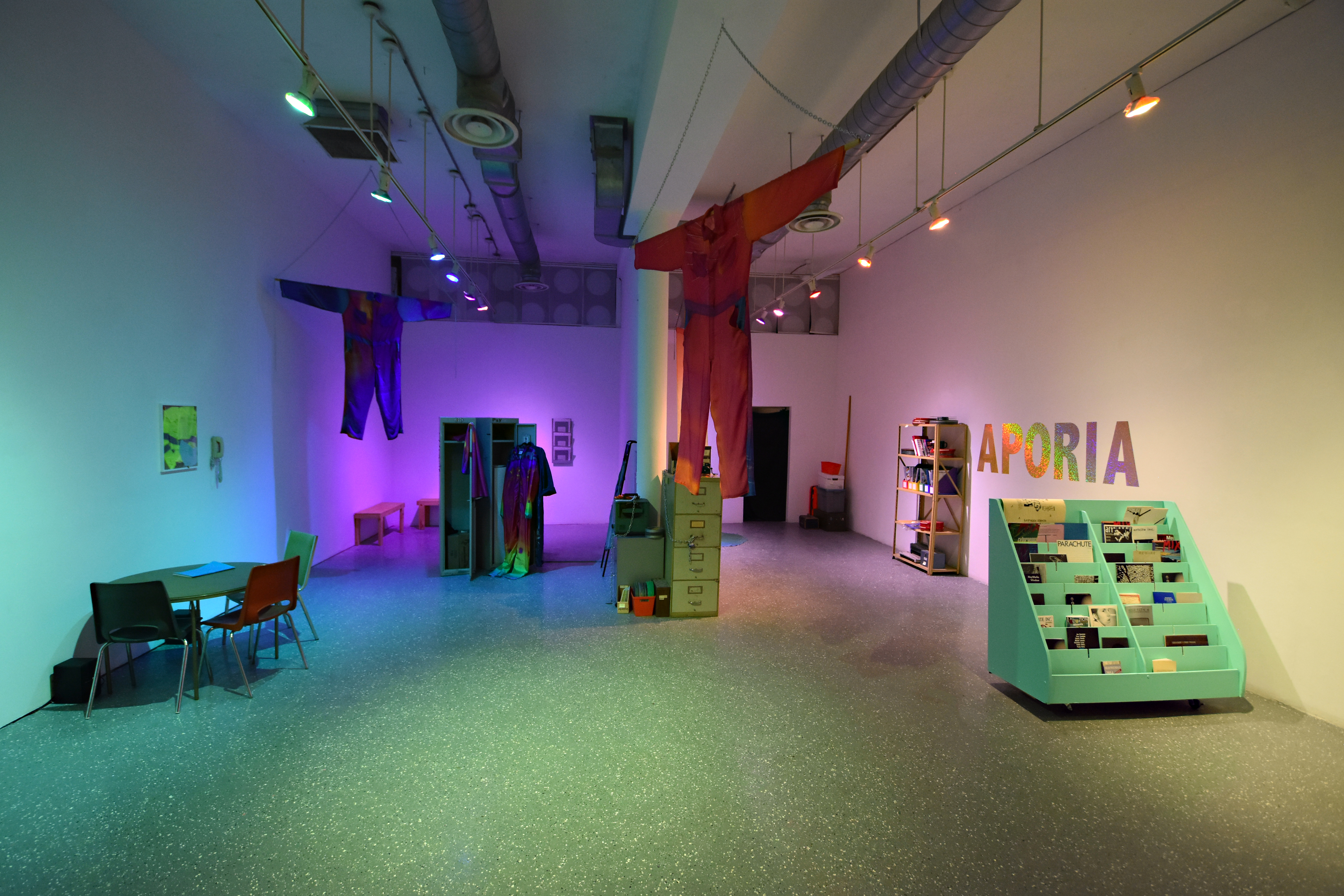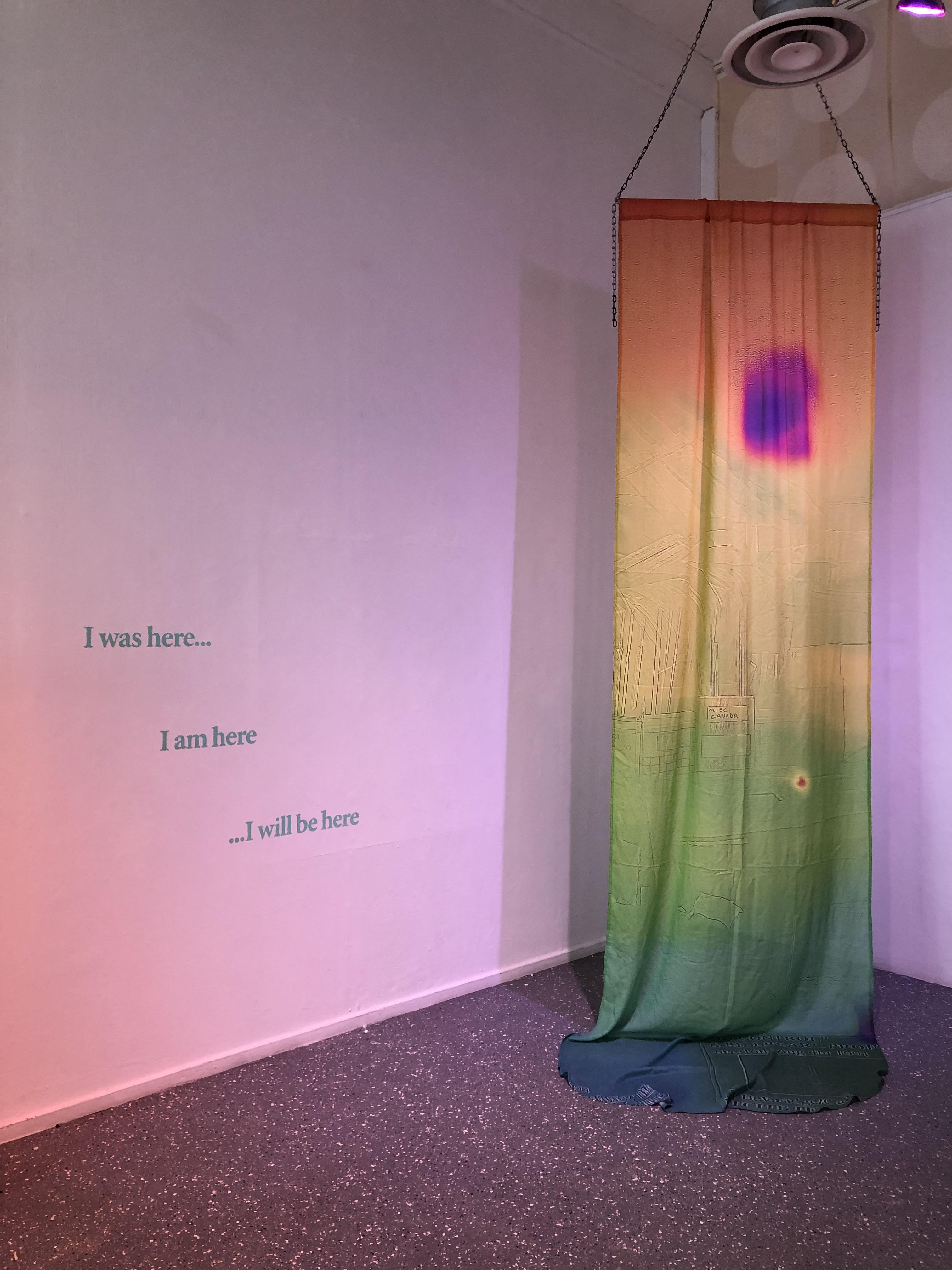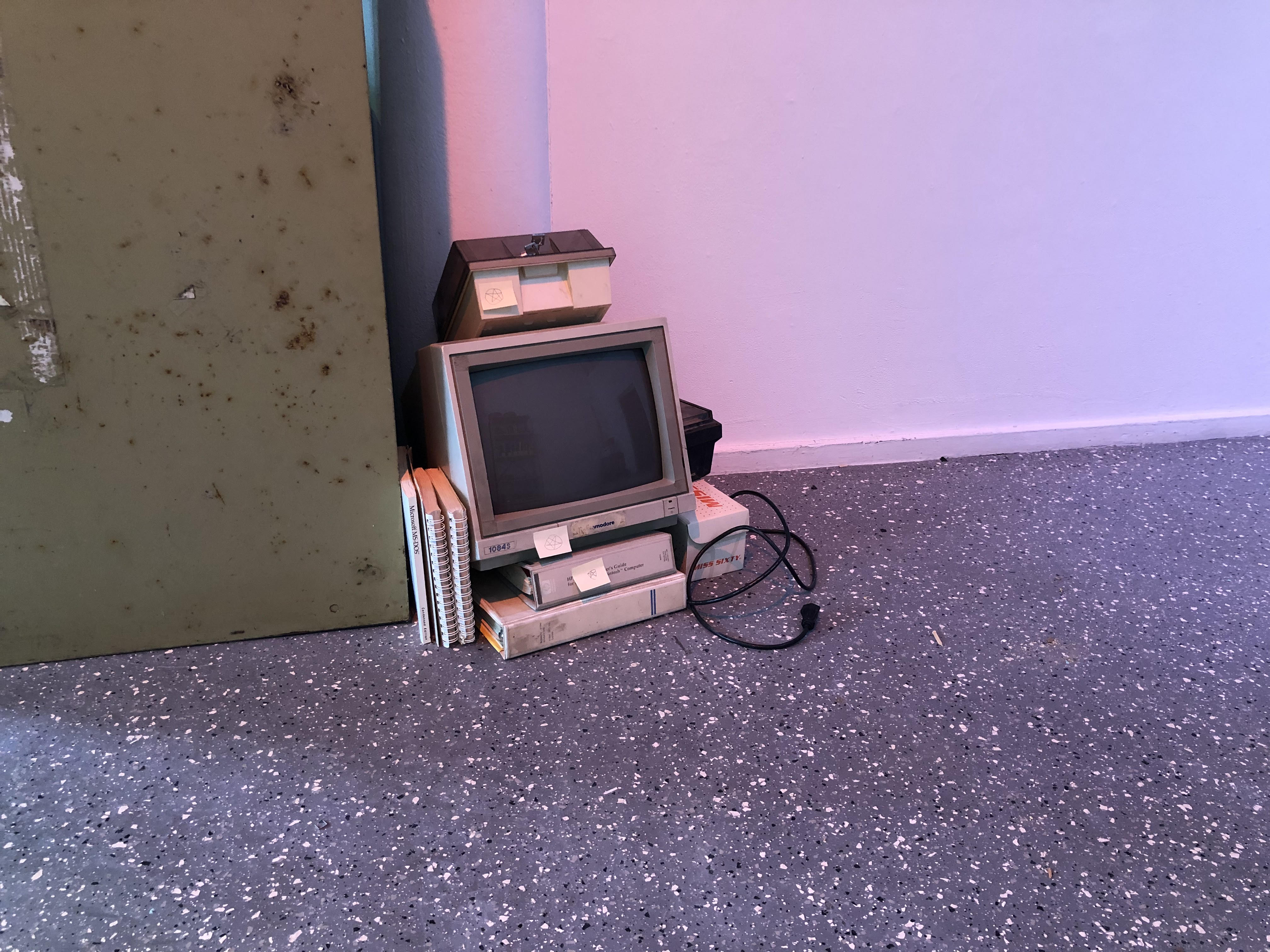Review of Morris Fox’s Vestiges and Remains at Artcite Inc.
February 21, 2023, by Imogen Clendinning

Vestiges and Remains, Morris Fox, photo taken by Kristina Bradt
Vestiges and Remains, an exhibition by Morris Fox, is a séance with a haunted Artist-Run Centre’s archive. Fox’s exhibition, presented by Artcite Inc. (Waawiyyatanong/Windsor, ON), invigorates the gallery’s expansive archive, through the creation of new infrared video and images, video-works, and abstract interventions into the archive. The artist collaborates with dusty manuals and board minutes, activating 16mm found footage, old arts publications, and dirty worksuits. A queer artist and new gothicc writer, Fox acts as the ‘Exhibition Programmer,’ exploring the mystical, the poetic, and the utopian potentials of the speculative. Fox activates the Gothic as an aesthetic device; queering the archive and building community through intervention. Vestiges and Remains excavates the gaps in knowledge embedded in archival documents, and the trauma of those absences.
The Artcite Inc. gallery has been located in the heart of Windsor’s downtown since the early 90s, and since this time, the organisation has amassed a unique collection of artifacts of the artist-run centre’s history. Stored under the white cube in a dusty basement, what Fox refers to as a crypt, Artcite houses a collection of board minutes, film reels, furniture, TVs and monitors, projectors and various other bits of idiosyncratic ephemera. Artcite’s first mandate and mission was steeped in counter-cultural defiance, and throughout the decades their programming has featured fringe and highly contemporary creative approaches to the creation and circulation of art in Canada. Ultra punk and radical in their approach, Artcite ran a number of events which challenged convention– including site-specific festivals, music events and exhibitions.
On the other hand, Artcite, along with many other organisations, has reckoned with the structural racism which is embedded within the art scene in Canada. BIPOC community members, artists and the Artcite staff have been working to enact new policy and commitments towards an anti-racist approach in both their work and programming. Within this complex context, filled with grey areas and contradictions, Fox begins to sift through the archive.

shroud, Morris Fox, thermal imaging and textile sculpture, January 2022
Fox says of Vestiges and Remains, the exhibition “explore[s] the haunted temperature of archives, community memories and the ghosts of labour.” Fox’s works encourage reflections on the nature of an artist-run centre’s archive as both a theoretical form of constructing time, and a tangible record of the past. For Vestiges, Fox created a series of assemblages of objects and materials from Artcite’s basement, textile sculptures featuring thermal imaging video taken in the archive, three channels of video-works, and a sound piece which plays throughout the gallery space. Fox also staged a number of areas where visitors could sit and look through archival materials and his own research.
Mood and lighting play a key role in setting the tone for Fox’s installation. The objects in the gallery are refracting light in purples, greens and yellows through the light installation Rainbow’s End. The sound-piece Ghost Transmissions murmurs in the distance, and the exhibition is laid out in such a way that intimate pockets of experience abound; the urge to explore is inevitable. Textile sculptures hang from above the viewer’s head. Objects from Artcite’s dusty basement are delicately juxtaposed, including a Commodore computer monitor on the floor, a floppy disk case and printer manuals stacked on top of it. Meticulously staged, these assemblages allow the visitor to consider how objects transform through time in a poetic state of becoming.

archive cairn, Morris Fox, found object assemblage, January 2022
Throughout the exhibition, the viewer can recognize The Gothic in Fox’s language and aesthetic framing. In the sound piece Ghost Transmissions, there are references to the séance, the crypt, ghosts and mediums, and the reanimation of objects from the Artcite basement - which Fox purposefully kept dusty to allude to their former life buried underground.
In my interview with Fox, he describes the relationship between queerness, The Gothic and the archive as being connected through hauntings,
“The haunting of identities, and objects which keep on coming back, the ghosts that are saying “We are here, pay attention to us.” That’s important. And it’s differentiated from trauma for example. Traumatic history, the experience of trauma is something that repeats continuously until it's healed. Whereas haunting is a bit more ambiguous within its role and also the feeling that we have with it.”
In Ghost Transmissions Fox reflects on the distinction between the physical form of the archive, and the theoretical potential of these ephemera and materials. The audio-piece considers archives as haunted effigies resurrected and forced into the context of the present through their activation by artists and researchers. The work also addresses the power structures present in archival documentation, pointing to the accumulation of past materials as a problematic and capitalist pursuit that governs us through “bureaucratic catastrophe.” Ghost Transmissions plays in the gallery from small speakers beneath a circular card table, where three empty chairs sit in waiting. Here, the audio transforms into a sonic cue, subtly inviting the viewer and their comrades to sit and critically discuss the nature of the archive, probing the differences and similarities from the theory and the archival object. The work also mirrors a collective processing of erasure and mortality; the futility and nostalgia wrapped up in the archive and the study of the past.

worksuit shroud, Morris Fox, thermal imaging and textile sculpture, January 2022, sewn by B. Wijshijer.
The exhibition is defined by the hauntings of labour within archives and artist-run culture. Fox and the Artcite staff used a thermal imaging camera to document the physical degradation of Artcite’s archive. They shot video in the dark basement of the gallery, gathering colourful shots of film projectors, binders, and notes. This use of temperature reading in the gallery becomes a mode of bringing an aesthetic framing to the archive, dressing it in a kind of costume. Through its use there is a careful play between the nostalgic magic of pastness and a seemingly unbiased bureaucratic document. The footage from the infrared camera was then used to create a series of textile artworks, including a shroud which hangs by the back wall on the right side of the gallery space, as well as a series of worksuit shrouds created by Fox and studio assistant B. Wijshijer. The worksuits are a dominating force in the gallery space, two of which hang outstretched, in a kind of “cookie cutter” splayed position, floating above the viewer’s head. The others are hung and stacked within a locker in the centre of the gallery space, on the left side. Fox was interested in the ghosting of labour which exists beneath the surface of Artcite’s archive. The labour baked into Artcite’s gallery space is subtle but viscerally present to its staff and visitors. Through the installation, Fox renders visible the emotional labour of cultivating a community which cares for its members and the constant labour of fighting for equity and radical change through the arts.

polaroid documentation, Morris Fox, January 2022, polaroids taken by Fox and Artcite Inc. staff, photo taken by Kristina Bradt
These forms of labour are alive in the Artcite archive: in the hand-drawn signs from past protests and sit-ins, the hand-folded publications and hand-pressed buttons, as well as in the emotional commitments to the space which are present in the board minutes. The worksuit shroud is a manifestation, a ghost of past labour that refers to the physicality of this work. The infrared worksuits are displayed beside an old set of coveralls that have lived at Artcite for many years, and according to Fox it is in this fabric that the DNA of past volunteers is present within the exhibition. “It’s literally the blood, sweat and tears being infused with these costumes.”
Morris Fox’s Vestiges and Remains is a vast exploration of archival material, mythologizing the artist-run centre through excavations and séances. More prominently, the exhibition is grounded in a study of collaboration and community, creating an environment for discussions of resistance and futurity.


Vestiges and Remains exhibition poster, Morris Fox, January 2022
Necro Archive, Morris Fox, 2022
Author’s Note:
I would like to acknowledge the prolific work and legacy of Artcite Inc.’s former Executive Director Christine Burchnall, aka ‘X’ in the board notes. Christine was a force, a massive contributor to Artcite’s history, and the arts community in the Windsor/Detroit area more broadly. Rest in power Xtine.
1 https://www.artciteinc.ca/exhibitions/vestiges-and-remains
2 Interview between Morris Fox and Imogen Clendinning.
3 Interview between Morris Fox and Imogen Clendinning.
Morris Fox (he/they) is an artist, poet and educator, born in Tkaronto (1984). He graduated from the Low Residency MFA program at SAIC in 2018, and is an Interdisciplinary Humanities PhD Candidate at Concordia U (Fall 2022), where he is conducting research-creation via temporary community formations, queer hauntings, and goth ecological action. Fox’s work manifests in performance, textiles, video, and writing. He performed in VR as a bat for Claudia Hart’s Ludicy (2021-2022), created avatars and virtual environments for Gothwerk Revelations, curated by Maggie Wong, in Hotwheelz Festival (Chicago, 2020), worked as the textile intern for The Icelandic Textile Centre (Blönduós, 2020), and was curated by Jordan Olivia Turk in An Archive of Feelings (Randolph, VT, 2019). Their show Vestiges & Remains at Artcite Inc. (Windsor, 2022) explored the haunted temperature of archives, community memories and the ghosts of labour. In his show My Gay Mediaeval Times at Spacemaker II (Tkaronto, 2022), Fox wove together fictocriticism, queer medievalism, solastolgia through encrypted chainmaille works.
Imogen Clendinning (her/they) is a video artist, emerging curator and academic currently residing in London, ON. Their research concerns include DIY approaches to the archiving of net-based practice and sustainable digital archives with speculative potentials. She is currently pursuing a PhD in Art and Visual Culture at the University of Western Ontario. Clendinning has exhibited and screened her found footage films across Ontario and Quebec, and has worked in Artist-Run Centres and DIY community driven spaces for over six years.
